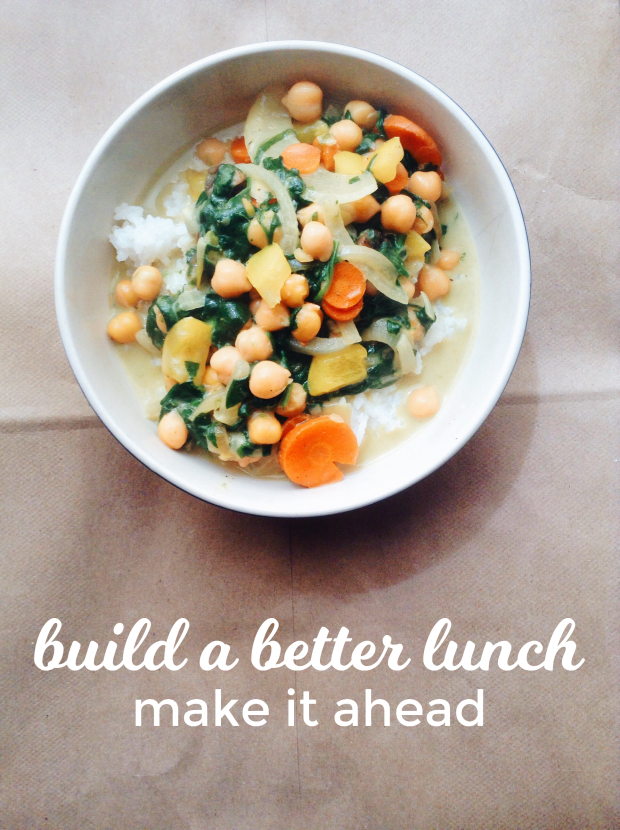This is part four of the Build a Better Lunch Series. Read about the framework, sandwiches, and salads!
There is something so awesome about being able to pull an awesome meal out the freezer, pop it in the microwave, and be off.
Last year, my go to was Trader Joe’s Fusilli with Vegetables and Basil Pesto (let me tell you, it was tops). But at $2 a pop, I could make two weeks’ worth of lunches at the cost of a week of the pre-made Trader Joe’s lunches. All it took was an hour on Sunday after dinner to whip up eight meals (since I just go to school four days a week, that’s two weeks!). Well, an hour, a small squash, an onion, a bell pepper, pasta (I came to like bow ties the best), and pesto.
It was quick and easy–in the time it took to boil the water and make the pasta, I had the veggies sautéed and had sauce portioned out into the little baggies. All that was left was to measure out a cup of pasta per meal (baggy) and
But from there, I became more adventurous: I went the curry and stir-fry route. But you can make casseroles, Latin-inspired fare (I bet homemade burritos would freeze well–now that I think about it, I should probably try it!), or even fancier things, like chicken thighs with steamed veggies and rice pilaf.
Just package it up in a mason jar or a baggy*, freeze it, and you’re good to go.
Pick a Protein, Select a Starch
When I meal plan, I like to think in terms of the starch and the protein. When I make my take on the Trader Joe’s fusilli, I always have a hard-boiled egg with it–otherwise, I fall asleep and end up hungry by 3 in the afternoon.
You can think of the starch and protein as your base. The starch offers volume and the protein keeps you full longer, as I mentioned last week. Think chicken and pasta, eggs on toast, rice and beans. For instance, my curry counts on rice and chickpeas for the complete protein and starch.
For the sake of simplicity, let’s base our example meal on a small chicken breast or thigh (your preference) and a cup of pasta.
Veggie Variation
The next step is getting your plant foods. In case you missed it, fruits and veggies are awesome for you. They provide you with all sorts of necessary micronutrients (think vitamins and minerals) and in the process, give you that glow of health. So pack ’em in!
The average young woman needs about two and half cups of veggies per day and two cups of fruit. At lunch, that might mean a cup of each. Try carrots, onions, and celery together for a classic flavor combination. Or go for bell pepper, spinach, and tomatoes for a rainbow of color.
Let’s say our example meal includes a cup of roasted summer squash, tomatoes, bell pepper, and onions. When the meal comes out of the freezer, a cup of strawberries added on the side helps to round out the meal as a serving of fruit.
Don’t Forget Calcium
According to the USDA, the dairy food group consists of the “calcium” foods. Don’t forget that if dairy disagrees with you, you can opt for lots of green veggies or calcium-enriched foods (anything from soy yogurt to nut milks to orange juice–in moderation, of course).
In this example lunch we are building, there are two options that spring immediately to my mind: freeze it or add it later. We could choose to a bit of cheese to go with our pasta, chicken, and veggies or we could opt for yogurt to packed with the strawberries. In this case, I vote…both. A sprinkle of Parmesan will be nice on the pasta, and will account for the rest of the dairy serving not provided by a 6 ounce cup of yogurt.
Savor Sundry
Now, we get to fats and flavor-enhancers. Things like fresh ginger or rosemary. Olive oil. Salsa. Pesto. The works. Of course, it’s important to check portion size, either because it is highly caloric (pesto and oil, I’m looking at you!) or sometimes overly flavorful (rosemary can be strong).
To finish off our sample lunch, let’s add just enough olive oil, salt, pepper, garlic, and rosemary to just coat the pasta.
All Together Now!
When it’s time to eat our homemade frozen entrée, I have found that microwaving between 3 and 4 minutes is enough for a frozen meal typically. If you choose to defrost your meal in the freezer overnight, 30 seconds to a minute long zap should be enough. I highly recommend playing around with reheating times to find what works best with your meals.
Now, our sample meal plan looks like frozen entrée made up of a cup of pasta, a 2 or 3 ounce chicken breast, a cup of roasted veggies, some olive oil and seasoning, and a bit of shredded cheese, in a jar or a baggy* all together. In the morning, it’s defrosted, reheated, and packed with a cup of strawberries and 6 ounces of yogurt. This hits on all the food groups outlined when we developed our framework.
*Since mason jars can break in the freezer and because they take up more space than I currently have, I have been using BPA-free plastic baggies. In case there is an issue with other chemicals beyond BPA, I try to minimize chemical leaching by never putting hot food in the baggies. This means letting pasta, rice, cooked veggies, sauces, and the like cool down before packaging it up. I also plop the frozen meal into a microwave safe bowl before cooking it so that the plastic isn’t microwaved.

